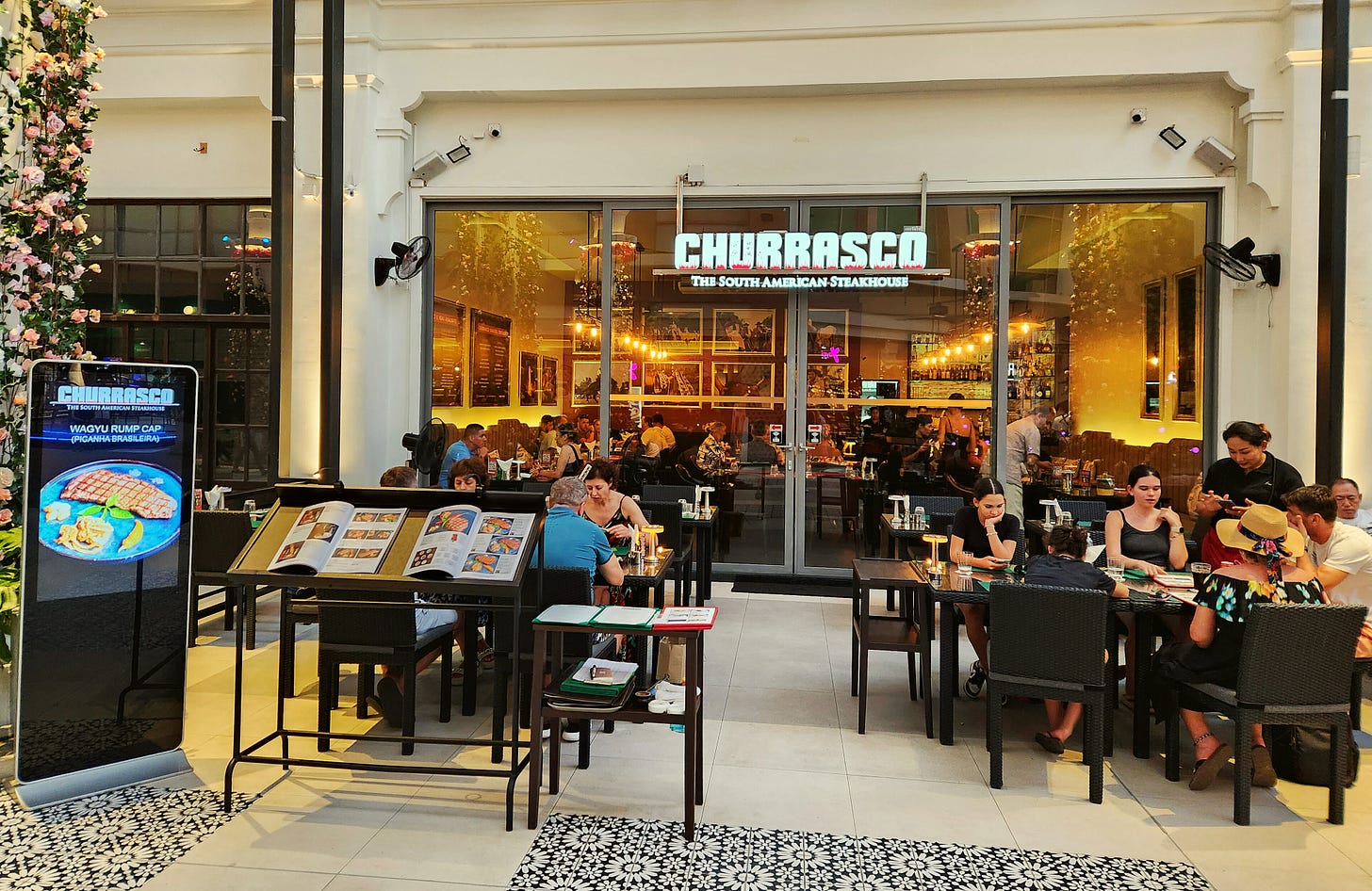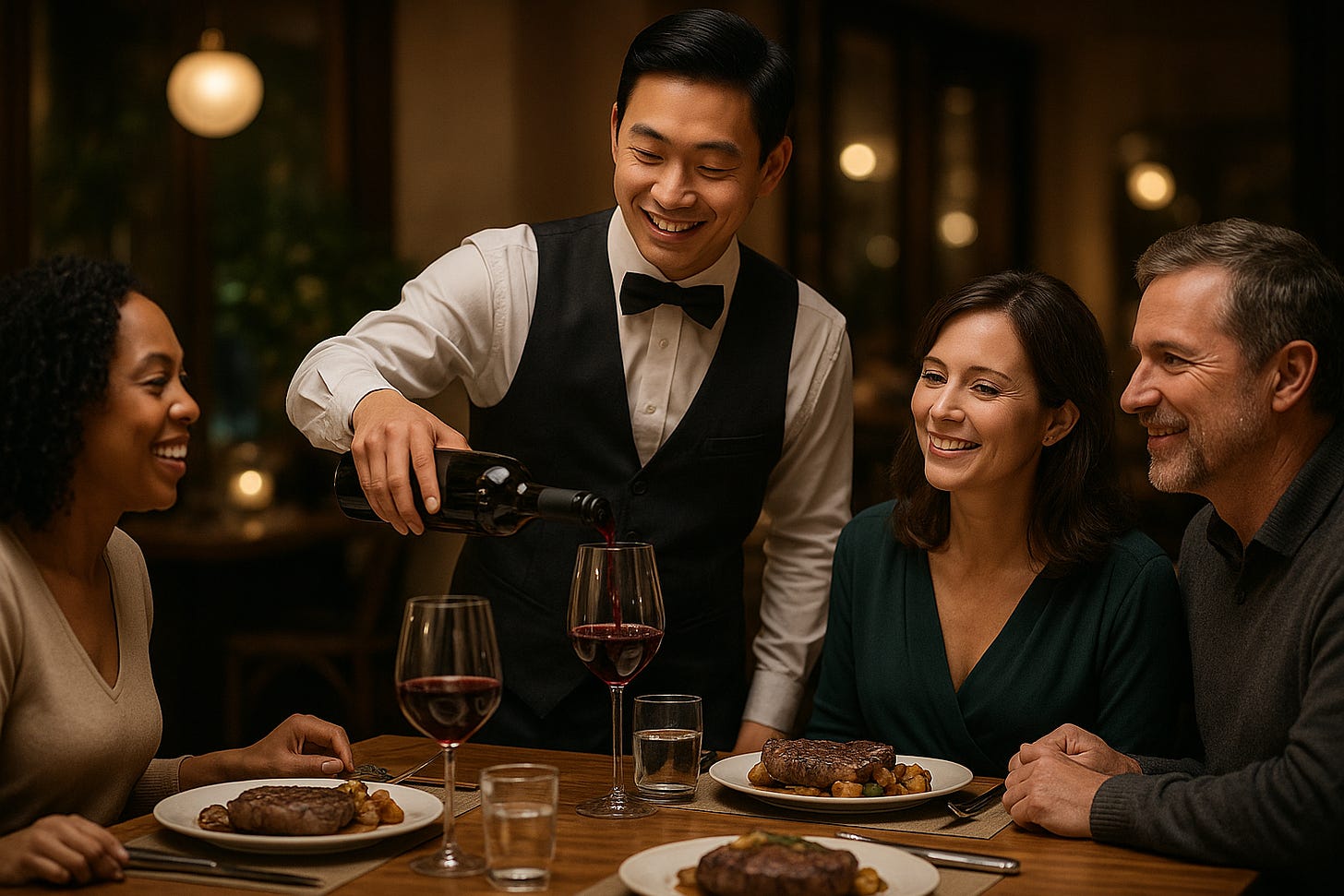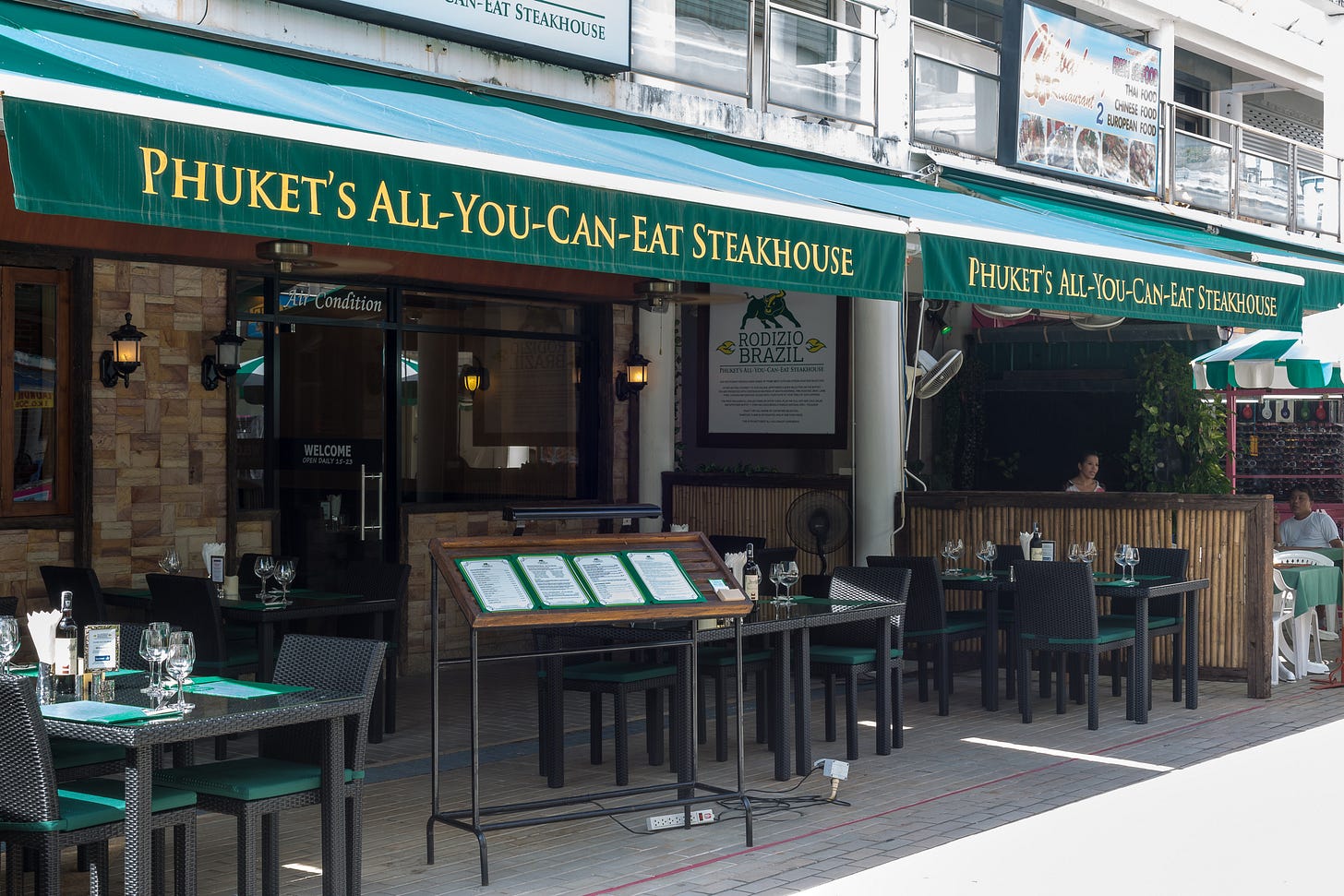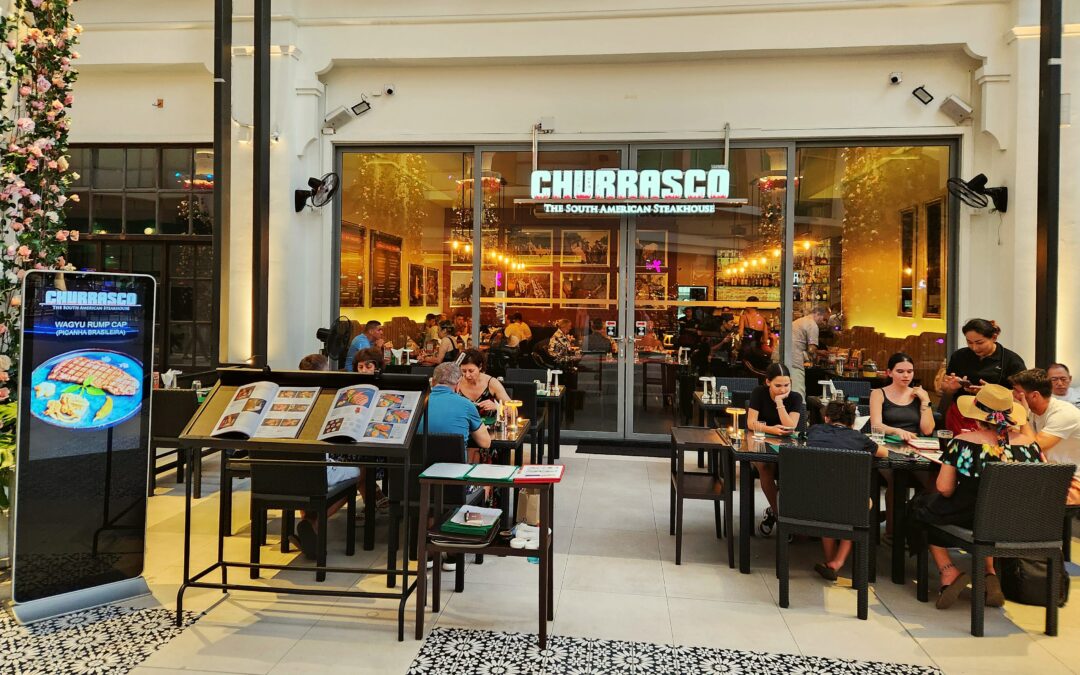
by lspeed | Aug 10, 2025 | RESTAURANT BUSINESS: BEHIND THE KITCHEN DOOR
THE RESTAURANT INSIDER: WHAT’S NEW?
Discover Our Latest News & Updates Here:
BLACK BOX: RANTS, RAVES, REVIEWS & RECIPES
KNOWLEDGE: MEAT ESSENTIALS
WINES: UNCORKING THE MYSTERY
LIQUORS: LIFT YOUR SPIRITS
DECODING GRAPES: FROM VINES TO VINTAGE
RESTAURANT BUSINESS: BEHIND THE KITCHEN DOOR
ACCESS ALL ARCHIVED STORIES HERE:
_ _ _
© CHURRASCO PHUKET STEAKHOUSE / ALL RIGHTS RESERVED
Reprinting, reposting & sharing allowed, in exchange for a backlink and credits
Churrasco Phuket Steakhouse serves affordable Wagyu and Black Angus steaks and burgers. We are open daily from 12noon to 11pm at Jungceylon Shopping Center in Patong / Phuket.
We are family-friendly and offer free parking and Wi-Fi for guests. See our menus, reserve your table, find our location, and check all guest reviews here:
Home
#Churrascophuket #jungceylon #phuketsteakhouse #affordablewagyu #wagyu

by lspeed | Aug 3, 2025 | RESTAURANT BUSINESS: BEHIND THE KITCHEN DOOR
Whether praising a beachfront bungalow or complaining about a disappointing dinner, travelers turn to Google, TripAdvisor, or social media to share their experiences. But in Thailand, the legal consequences of what you write can become a lot more serious than many tourists expect.
Thailand is an amazing and welcoming country, but it has very strict defamation and cybercrime laws that apply to anyone within its jurisdiction – including visitors. While fair and honest reviews are welcomed by businesses and other travelers alike, reviews that are overly harsh, misleading, or accusatory expose the reviewer to criminal or civil liability – even if they believe them to be justified.
Here’s what you need to know and carefully consider:
Defamation Is a Criminal Offense in Thailand
Most countries handle defamation as a civil matter. Thailand treats it as a criminal offense. Under Sections 326–328 of the Thai Criminal Code, defamation is defined as making a statement about someone that could damage their reputation, expose them to hatred, or lower their status in the eyes of others. If the statement is made publicly, such as through an online review, the potential penalties increase. Reviewers could face up to two years in prison, a fine of up to 200,000 baht (about USD 5,500), or both.
This doesn’t mean that writing any negative review will land you in legal trouble. But it does mean that:
The Computer Crime Act Adds Another Layer
Thailand’s Computer Crime Act (CCA), especially Section 14, is often used in tandem with defamation laws. It makes it a criminal offense to input false information into a computer system that could cause harm to others. For example, posting a negative review on a website or social media platform that contains what a business claims is false or misleading information could fall under this law. The penalties are significant—up to five years in prison, a fine of 100,000 baht, or both. This law has been used in past cases where negative reviews led to arrests and legal disputes, especially in cases involving small hotels or restaurants that believed their reputation had been unfairly tarnished.
Real-World Precedents
One notable case occurred in 2020, when a foreign guest posted a negative review of a resort on Koh Chang. The hotel filed a complaint, and the guest was briefly detained under both defamation and computer crime charges. The case was eventually resolved through mediation, but it drew global attention and highlighted the potential risks for tourists unaware of local laws. Other businesses have taken similar actions in response to reviews they deemed false or damaging, especially when they included accusations of illegal or unethical behavior.
What’s Safe to Say in a Review?
Thailand’s laws don’t prohibit honest opinions or fair criticism. The key is to:
-
Stick to personal experience: Describe what happened without assuming motives or making unprovable claims.
-
Use neutral language: Say “The service was slow” instead of “The staff were lazy.”
-
Avoid broad accusations: Never claim a specific restaurant gave you food poisoning, unless you’ve had it medically confirmed and in writing.
-
Refrain from insults: Calling a business “a scam” or “a fraud” are grounds for legal action, unless you can prove it.
It’s perfectly acceptable to express disappointment or frustration. Just be sure your review is constructive, fact-based, and written in good faith.
Practical Advice for Tourists
-
If you have a serious issue with a hotel or restaurant, raise it with management first. Many problems can be resolved on the spot.
-
If you do choose to write a negative review, consider doing so once you’ve returned home, where different legal protections may apply.
-
Be aware that anonymous usernames won’t shield you from liability in Thailand. Authorities can trace online identities if a formal complaint is filed.
Final Thoughts
Thailand rightfully is one of the world’s most popular and loved travel destinations, with a thriving hospitality industry that values feedback. Most businesses welcome reviews and use them to improve. However, it’s important to understand that the legal landscape here is different, and sometimes stricter, than elsewhere. When in doubt, focus entirely on provable facts, keep your tone fair, and remember that constructive criticism goes further than anger.
Image Credit: https://churrascophuket.com
_ _ _
© CHURRASCO PHUKET STEAKHOUSE / ALL RIGHTS RESERVED
Reprinting, reposting & sharing allowed, in exchange for a backlink and credits
Churrasco Phuket Steakhouse serves affordable Wagyu and Black Angus steaks and burgers. We are open daily from 12noon to 11pm at Jungceylon Shopping Center in Patong / Phuket.
We are family-friendly and offer free parking and Wi-Fi for guests. See our menus, reserve your table, find our location, and check all guest reviews here:
https://ChurrascoPhuket.com/
#Churrascophuket #jungceylon #phuketsteakhouse #affordablewagyu #wagyu
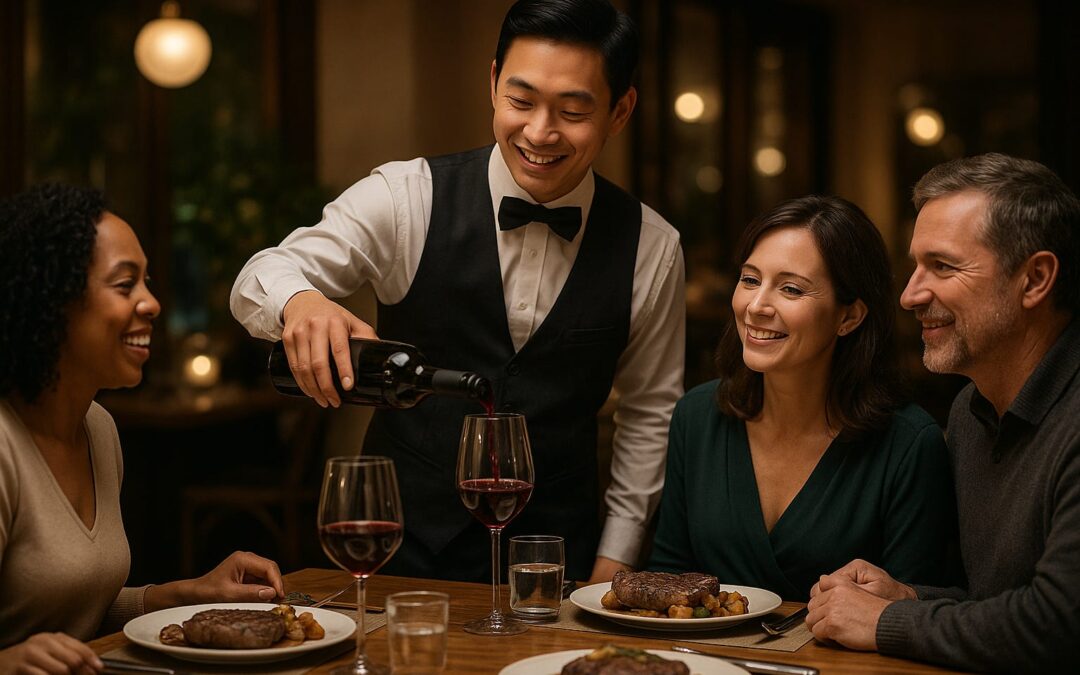
by lspeed | Jul 27, 2025 | RESTAURANT BUSINESS: BEHIND THE KITCHEN DOOR
Restaurants tend to treat wine as a menu item – an upselling opportunity, a pairing idea, and a profit markup. But for most guests, it carries a lot more weight and cost. In this scenario, a glass of wine isn’t just a drink, it forms part of the overall dining experience. It marks a celebration, quiets a long day, or complements an important conversation. When wine service taps into that emotional context, it becomes something far more meaningful than just a pour.
Most diners aren’t looking for deep dives into terroir or tannin structure. What they want is something that fits and elevates “the moment”. A wine that feels right, not just one that pairs right. This is where service teams can shift their focus, from reciting facts to reading the room. Sometimes the best recommendation isn’t the most expensive bottle, but the one that matches the tone of the evening.
There’s also value in storytelling, not as a sales tactic, but as a way of making wine approachable. A guest might not remember a label, but they’ll remember, “This reminds me of late summer in Tuscany.” Small details like that create connection. It’s not about showing off wine knowledge; it’s about offering something human, something that resonates.
This doesn’t mean formal wine service is outdated. There’s a place and demand for polished technique and expertise, especially in fine dining. But even in those settings, tone matters. Hospitality today leans more toward engagement than hierarchy. The goal isn’t to impress, it’s to invite – to suggest and not instruct. The best servers and sommeliers know how to meet guests where they are, whether they’re wine-savvy or just browsing the list.
And what about the wine list itself? It doesn’t need to be long or expensive to be effective. A short, focused list that reflects the restaurant’s identity often connects better than a broad, impersonal one. What matters most is that the staff feels comfortable navigating it—and that it offers choices suited to the mood, not just the menu.
Wineries and restaurants are beginning to move away from polished bottle shots and toward atmosphere. A candlelit table, a clinking glass, a quiet moment with friends, that’s what resonates and remains. People rarely buy a wine just for the label, they buy it for the feeling they think it will bring. Ultimately, wine service isn’t about technical performance, it’s about presence. About understanding that wine has the power to shape an evening, not dominate it.
Restaurants that recognize this, both casual and high-end, often leave a stronger impression with guests. Because when the bottle is finished and the table cleared, what stays with people isn’t the varietal. It’s how the wine made them feel.
Image Credit: https://churrascophuket.com
_ _ _
© CHURRASCO PHUKET STEAKHOUSE / ALL RIGHTS RESERVED
Reprinting, reposting & sharing allowed, in exchange for a backlink and credits
Churrasco Phuket Steakhouse serves affordable Wagyu and Black Angus steaks and burgers. We are open daily from 12noon to 11pm at Jungceylon Shopping Center in Patong / Phuket.
We are family-friendly and offer free parking and Wi-Fi for guests. See our menus, reserve your table, find our location, and check all guest reviews here:
https://ChurrascoPhuket.com/
#Churrascophuket #jungceylon #phuketsteakhouse #affordablewagyu #wagyu
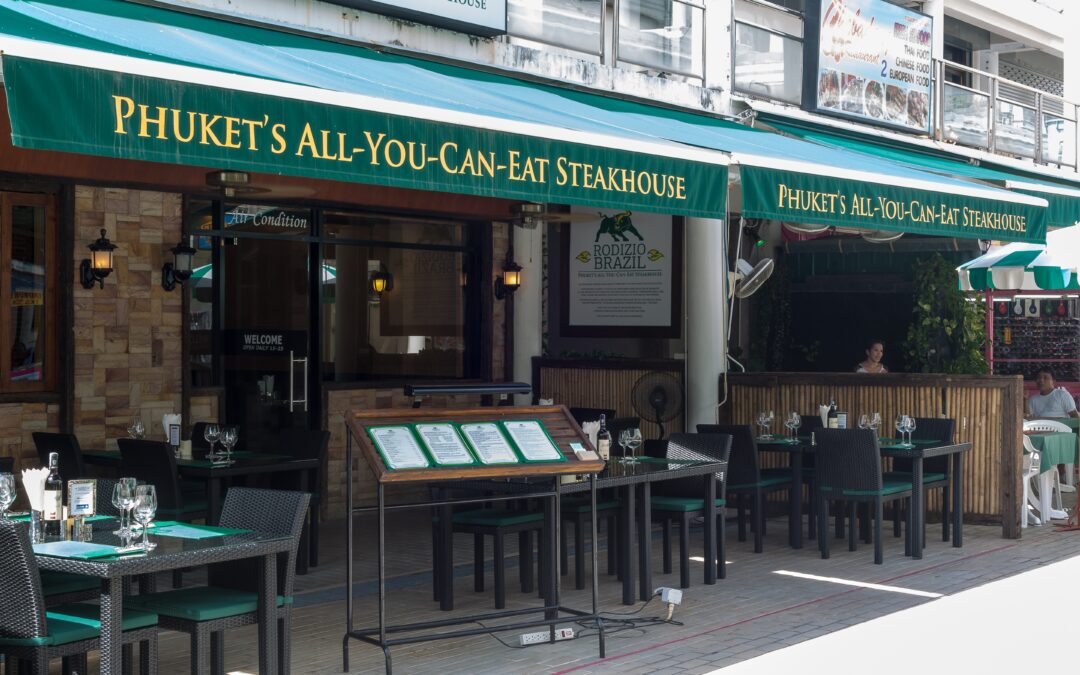
by lspeed | Jul 13, 2025 | RESTAURANT BUSINESS: BEHIND THE KITCHEN DOOR
When it comes to steakhouses, some crave the polish of a classic à la carte steakhouse, as presented by Churrasco Phuket Steakhouse, while others are drawn to the energy and abundance of a rodizio-style churrascaria. But behind the scenes, for restaurant owners and operators, the decision between these two formats is about much more than aesthetics or ambiance.
Each model has its own operational demands, cost structures, and profit potential. Choosing the right one means balancing guest expectations with kitchen efficiency, labour management, and long-term financial viability. Here’s a breakdown — not just from the guest’s side, but also from the business owner’s perspective.
À La Carte Steakhouse: Premium Product, Precision Service
In an à la carte steakhouse, guests choose exactly what they want – their preferred cut, weight, and doneness. Sides, sauces, and extras are all ordered separately. This format emphasizes control and customization.
Advantages for Guests
Full Customization: Perfect for diners who know what they want and expect it done just right.
Perceived Prestige: High-end cuts, fine wines, and elegant plating appeal to business dinners and special occasions.
Quiet, Focused Experience: Often chosen for its more refined and intimate environment.
Advantages for Owners
Higher Margin: Premium beef cuts come at a cost, but when paired with up-charged sides, sauces, and drinks, margins can be strong.
Inventory Control: Easier to forecast and portion since everything is ordered individually and prepped per item.
Brand Identity: Easier to build a premium or fine-dining brand around the à la carte model.
Challenges for Owners
High Labor Costs: Skilled grill chefs, trained waitstaff, and a larger front-of-house team are essential for quality and service consistency.
Wastage Risk: Unsold perishable cuts, especially expensive ones like Wagyu or dry-aged beef, can lead to loss if not managed tightly.
Limited Table Turnover: Dining is slower-paced, which can reduce how many covers are served in a night — especially if guests linger.
Rodizio-Style Churrascaria: Volume, Theatre, Controlled Chaos
Rodizio restaurants offer a fixed-price, all-you-can-eat feast where servers move from table to table slicing grilled meats straight off skewers. It’s lively, interactive, and built for abundance.
Advantages for Guests
Variety: A parade of meats — from picanha and lamb to chicken hearts and ribs — allows exploration without decision fatigue.
Set Pricing: No surprises at the end of the meal, which appeals to groups and budget-conscious diners.
Entertaining Experience: Tableside carving, shared energy, and generous sides create a festive, social environment.
Advantages for Owners
High Volume, Predictable Sales: Fixed pricing means consistent revenue per guest. High turnover and group appeal can drive up total sales.
Centralized Prep: Instead of dozens of different à la carte dishes, the kitchen focuses on bulk preparation of skewered meats and buffet-style sides.
Lower Front-of-House Labor: Passador servers manage most of the guest interaction, reducing the need for traditional table service staff.
Challenges for Owners
Meat Cost Management: Offering unlimited meat means balancing cost with portion control — trimming waste and monitoring consumption closely is key.
Operational Complexity: Maintaining dozens of skewers at precise temperatures and rotation timing can be a logistical juggle.
Difficult to Upsell: With everything included, it’s harder to drive up average spend unless drinks or desserts are successfully promoted.
Which Is More Profitable?
That depends heavily on location, pricing strategy, and target market.
À la carte restaurants can command higher per-person spend, especially if they lean into luxury beef cuts, premium wines, and fine dining ambiance. However, overheads — staffing, rent (for upscale areas), and ingredient cost are also high. Rodizio models rely more on volume and efficient food cost management. If meat is sourced strategically and labor is streamlined, margins can be excellent, particularly in tourist-heavy or family-oriented areas where the concept has broad appeal. In some cases, a rodizio can outperform à la carte in sheer cash flow due to higher guest throughput and set pricing. But for long-term brand building, à la carte offers more flexibility and prestige positioning.
Which Is Easier to Operate?
Again, it’s a trade-off. Rodizio kitchens focus on repetition and rhythm. Once the skewer system is in place, the process becomes about timing and consistency. Labor can be more standardized, and table service is simplified. À la carte demands culinary finesse and front-of-house coordination. Every steak is cooked to a specific order, timing matters, and guest expectations are high. Training and experience are more critical. In general, rodizio is operationally simpler once the workflow is established, but à la carte offers more adaptability in pricing, portions, and specials — which can help with food cost optimization.
Other Factors to Consider as an Owner
Market Expectations: In high-income urban areas, à la carte may better match expectations. In resort towns or family-heavy markets, rodizio can shine.
Space Requirements: Rodizio often needs a large dining area and grilling infrastructure. À la carte can work in smaller, more intimate spaces.
Licensing & Food Safety: Rodizio’s tableside service and buffet setups may require stricter hygiene protocols, depending on local laws.
Staff Availability: If skilled chefs or experienced waiters are hard to find, rodizio’s format may be more sustainable in the long run.
The Choice
Making the call between à la carte and rodizio isn’t just about what’s on the plate, it’s about what goes on behind the scenes and on the balance sheet. Rodizio promises efficiency, volume, and theatre — a concept that works best where fun, generosity, and crowd appeal matter. À la carte is slower, more calculated, and often more prestigious — ideal for building a premium brand and delivering exacting quality.
Image Credit: https://insider.churrascophuket.com
_ _ _
© CHURRASCO PHUKET STEAKHOUSE / ALL RIGHTS RESERVED
Reprinting, reposting & sharing allowed, in exchange for a backlink and credits
Churrasco Phuket Steakhouse serves affordable Wagyu and Black Angus steaks and burgers. We are open daily from 12noon to 11pm at Jungceylon Shopping Center in Patong / Phuket.
We are family-friendly and offer free parking and Wi-Fi for guests. See our menus, reserve your table, find our location, and check all guest reviews here:
https://ChurrascoPhuket.com/
#Churrascophuket #jungceylon #phuketsteakhouse #affordablewagyu #wagyu

by lspeed | Jun 28, 2025 | RESTAURANT BUSINESS: BEHIND THE KITCHEN DOOR
A few years ago, most people (including me) didn’t know what on earth a QR code was. Now, you’ll find them front and center on restaurant tables across the world, often taking the place of traditional menus entirely. They’re simple: scan the square, scroll the menu, place your order. For restaurant owners, QR menus seem like a no-brainer. They save staff, money, they cut down on waste and speed up service. But while they’ve made life easier in some ways, they’ve also changed the dining experience in ways that aren’t for the better.
Real Business Benefits
First off, they’re cheaper. No more printing new menus every time you update prices or run out of a dish. You can make changes instantly, which is especially helpful for places with seasonal ingredients or daily specials. They also reduce staffing, since customers can browse and even order without waiting for someone to come by. That’s huge at a time when it’s tough to find and keep good front-of-house staff. In fast-casual spots or busy cafes, it keeps things moving and frees up employees to focus on other tasks.
There’s also the data. QR menus can show what people are clicking, how long they spend looking, what they skip, and what they order. That kind of insight can help you tweak your offerings or push certain dishes more effectively. Plus, digital menus can include nice extras, such as photos of dishes, allergen info, multiple language options, even wine pairings. From an operational standpoint, there’s a lot to like.
Something’s Missing
The biggest issue is that they take the soul out of the dining experience. The moment someone pulls out their phone, it shifts the vibe. Instead of settling in and engaging with the space or the people at the table, guests are staring at screens. The simple, human interaction of handing over a menu or walking someone through the specials is gone, gone, gone.
That small talk with a server? The chance for a recommendation, a story behind the dish, a bit of warmth? It disappears when a phone takes over the job. And that matters. In hospitality, those moments are what set great restaurants apart from the forgettable ones.
QR menus also miss upselling opportunities. A seasoned server can read a guest’s mood and suggest a great glass of wine or a dessert to share. A screen, no matter how well designed, doesn’t have that touch, unless in one of those dreaded pop-up screen. Yikes!
The Fast Food Vibe
There’s also the problem of “scroll fatigue.” Without a server guiding the experience, some guests get lost in endless lists of items, especially if the interface is cluttered or hard to navigate. A physical menu offers focus, and a human tactile experience. A digital one feels like you’re shopping online rather than enjoying a meal out. And that’s before you factor in bad Wi-Fi, poor lighting, or a phone running low on battery. It’s not just an inconvenience, it throws off the whole rhythm of a special night out.
Not For Everyone
Older diners, folks with visual impairments, and people who just want to unplug for a bit feel alienated when QR menus are the only option. Even tech-savvy guests might find them annoying when they’re forced to scan just to order a glass of water. And when digital ordering systems handle everything from the menu to the bill to the feedback form, the whole thing starts to feel less like dinner and more like a transaction at a fast food outlet. In fact, some countries and cities are now looking at making printed menus mandatory again. Just to make sure restaurants stay accessible and welcoming to everyone.
The Middle Ground
None of this though means QR menus are bad across the board. In the right setting, they improve efficiency. But restaurants need to be thoughtful about how and when they use them. The sweet spot? Give people options. Let guests choose whether they want to browse on their phones or hold a printed menu. Use digital menus as a support tool, not a replacement for staff. That way, you keep the tech benefits without losing the personal touch. Some restaurants even train servers to walk guests through the QR process and still offer suggestions and insights. Others use QR codes just for payment or special offers, keeping the rest of the service traditional.
Technology should support hospitality, not replace it. The best restaurants don’t just serve food, they create moments and memories by making people feel looked after. If we let convenience take the wheel completely, we risk losing the very thing that brings guests back again and again.
Image Credit: https://www.churrascophuket.com/menus
_ _ _
© CHURRASCO PHUKET STEAKHOUSE / ALL RIGHTS RESERVED
Reprinting, reposting & sharing allowed, in exchange for a backlink and credits
Churrasco Phuket Steakhouse serves affordable Wagyu and Black Angus steaks and burgers. We are open daily from 12noon to 11pm at Jungceylon Shopping Center in Patong / Phuket.
We are family-friendly and offer free parking and Wi-Fi for guests. See our menus, reserve your table, find our location, and check all guest reviews here:
https://ChurrascoPhuket.com/
#Churrascophuket #jungceylon #phuketsteakhouse #affordablewagyu #wagyu
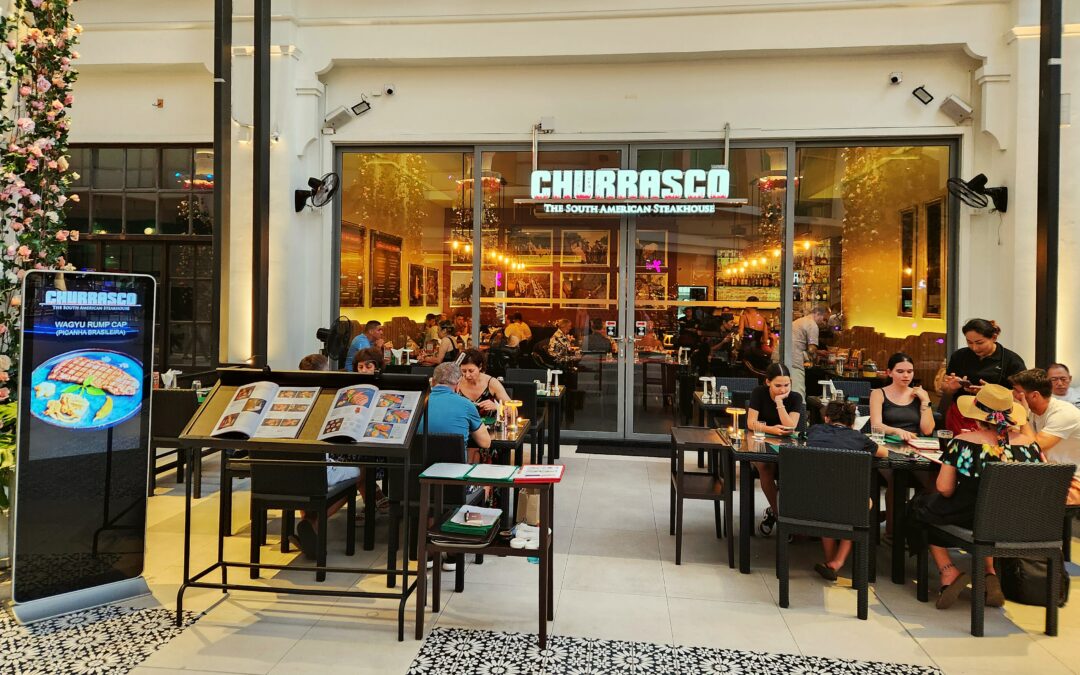
by lspeed | Jun 15, 2025 | RESTAURANT BUSINESS: BEHIND THE KITCHEN DOOR
When launching a restaurant, people obsess over menus, branding, chef talent, and interior design. And while all of these elements matter, there’s one decision that quietly looms – location. The wrong address can sink a promising concept before the first dish hits the table. The right one can carry even an average operation into some profitability.
While not a panacea for shortcoming elsewhere in the operation, the real estate cliché of “location, location, location” applies ruthlessly to restaurants. Food can be tweaked, service can be trained, and decor can be updated. But move into the wrong part of town, and you might never get the volume needed to survive.
Accessibility
At the most basic level, a restaurant needs to be reachable. It sounds obvious, but many newcomers to the industry fall in love with a charming space only to discover that it’s far from their target audience, or practically impossible to access during peak hours.
Ideally, your location should be well-connected to main roads, public transport hubs, or high-foot-traffic areas. A great chef won’t make up for the frustration of circling the block ten times or trekking down unlit alleyways. Whether you’re targeting office workers, weekend brunch crowds, or evening diners, the easier you are to reach, the more likely people are to return.
Parking
Ask any seasoned restaurateur about common customer complaints, and you’ll hear the common theme of parking. Even in cities with strong public transit, many diners prefer the convenience of driving. If they can’t park nearby, they’ll go elsewhere.
If your dream space doesn’t offer parking, you’ll need to get creative. Are there public lots within walking distance? Can you strike a deal with a neighboring business for evening use of their parking area? Is valet service a feasible add-on? Losing customers before they even step through the door because of parking quietly drains your numbers over time.
Visibility
Visibility often determines whether you attract casual walk-ins, tourists, or impulse diners. A tucked-away gem can work eventually, but only after word-of-mouth builds and your reputation does the heavy lifting. If you’re new to the market or working without a big marketing budget, this approach is very risky.
That’s why locations in malls, near intersections, shopping districts, or popular gathering spots carry so much value. They put your signage, your lighting, and your façade to work. People notice you even if they’re not looking for you. Over time, that passive exposure becomes name recognition, and that leads to visits.
The Lease
Many restaurateurs underestimate the role of lease terms in long-term viability. A space might be ideal today, but if your lease is short, restrictive, or subject to sudden rent increases, your stability evaporates. A restaurant needs time to find its rhythm. Opening buzz might fill seats for a few weeks, but building a loyal customer base, refining operations, and achieving consistent margins takes months – often years.
A long-term lease with clear renewal options gives you breathing room. It also makes it easier to invest in the space, whether that’s a new kitchen layout, outdoor seating, or custom décor. You’re not just renting space; you’re establishing a base of operations. The more stable your location, the more confidently you can plan.
Know Your Audience
A sleek cocktail bar will not thrive next to a high school. A vegan café struggles in a warehouse district full of late-night meat lovers. Know your audience, then choose a location that meets them where they already are, or where they’re happy to go. A poor location will almost certainly limit your potential. Location decisions require pragmatism, not just passion or dreams. It’s about traffic patterns, walkability, nearby competitors, and lease flexibility. Most of all, it’s about setting your business up for long-term relevance.
Consider the Future
Today’s bustling corner could be tomorrow’s construction site. Likewise, a quiet side street today might be the center of a major residential boom in five years. When evaluating a potential location, don’t just look at the present. Study city plans, development projects, and demographic trends. Is the area growing? Changing? Getting safer or riskier?
Talk to nearby business owners. Walk the block during different times of day. What seems promising in daylight might feel isolated after dark. Conversely, an unassuming store front could be gold if it sits beside a soon-to-open office tower or luxury condo development. Don’t just think about where your customers are now. Think about where they’ll be.
Choose your location like your future depends on it. Because in this industry, it does.
Image Credit: https://churrascophuket.com
_ _ _
© CHURRASCO PHUKET STEAKHOUSE / ALL RIGHTS RESERVED
Reprinting, reposting & sharing allowed, in exchange for a backlink and credits
Churrasco Phuket Steakhouse serves affordable Wagyu and Black Angus steaks and burgers. We are open daily from 12noon to 11pm at Jungceylon Shopping Center in Patong / Phuket.
We are family-friendly and offer free parking and Wi-Fi for guests. See our menus, reserve your table, find our location, and check all guest reviews here:
https://ChurrascoPhuket.com/
#Churrascophuket #jungceylon #phuketsteakhouse #affordablewagyu #wagyu


